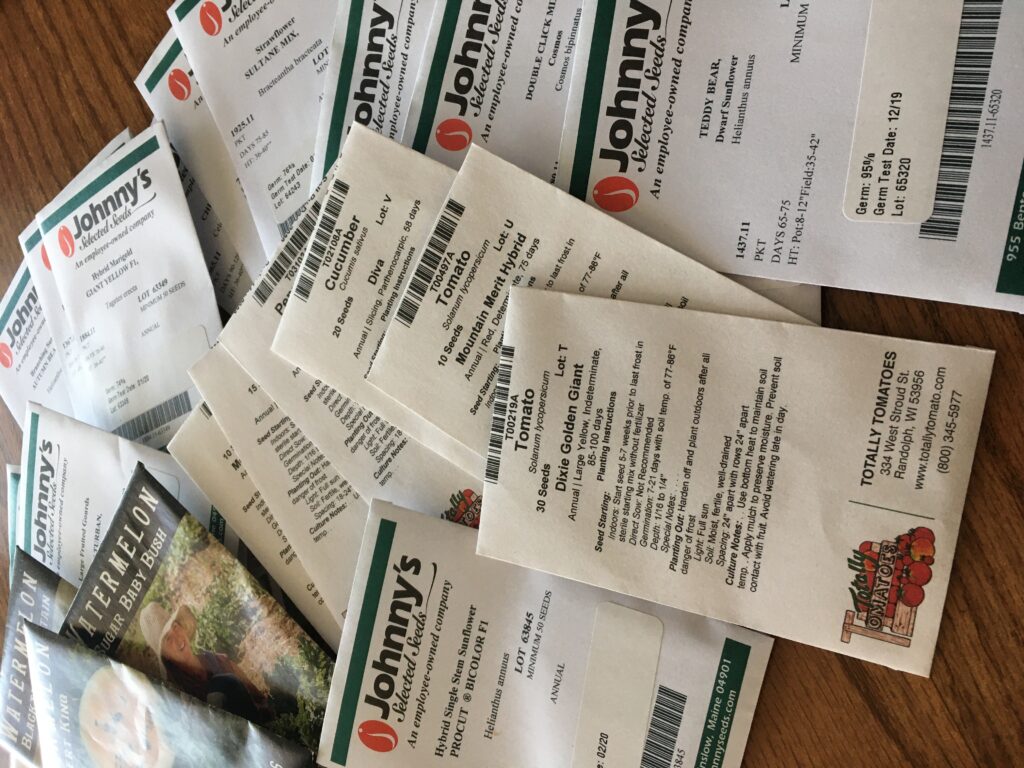Plan Next Year’s Garden by Ordering Seeds
go.ncsu.edu/readext?757420
en Español / em Português
El inglés es el idioma de control de esta página. En la medida en que haya algún conflicto entre la traducción al inglés y la traducción, el inglés prevalece.
Al hacer clic en el enlace de traducción se activa un servicio de traducción gratuito para convertir la página al español. Al igual que con cualquier traducción por Internet, la conversión no es sensible al contexto y puede que no traduzca el texto en su significado original. NC State Extension no garantiza la exactitud del texto traducido. Por favor, tenga en cuenta que algunas aplicaciones y/o servicios pueden no funcionar como se espera cuando se traducen.
Português
Inglês é o idioma de controle desta página. Na medida que haja algum conflito entre o texto original em Inglês e a tradução, o Inglês prevalece.
Ao clicar no link de tradução, um serviço gratuito de tradução será ativado para converter a página para o Português. Como em qualquer tradução pela internet, a conversão não é sensivel ao contexto e pode não ocorrer a tradução para o significado orginal. O serviço de Extensão da Carolina do Norte (NC State Extension) não garante a exatidão do texto traduzido. Por favor, observe que algumas funções ou serviços podem não funcionar como esperado após a tradução.
English
English is the controlling language of this page. To the extent there is any conflict between the English text and the translation, English controls.
Clicking on the translation link activates a free translation service to convert the page to Spanish. As with any Internet translation, the conversion is not context-sensitive and may not translate the text to its original meaning. NC State Extension does not guarantee the accuracy of the translated text. Please note that some applications and/or services may not function as expected when translated.
Collapse ▲During the winter season, gardeners are usually longing for more daylight and warmer temperatures so we can enjoy time in our gardens and landscapes. Winter, however, can be the time when garden enthusiasts can spend hours looking through seed catalogs, dreaming, and planning for their upcoming spring gardens. Eventually gardeners decided what new vegetable or flower cultivars to order along with ordering their long time favorites.
Now is a good time to start ordering seed catalogs. This way you can enjoy flipping through seed catalogs, admiring all the new flowers and vegetables available during the winter month. If you have access to the internet, it is very easy to do a search for seed catalogs. Many vegetable and flower seed catalogs can be found on the internet where many of the websites have a place you can request a free catalog simply by submitting your name and mailing address.
Although most seed companies will have sufficient quantities of seed to fill orders it is still a good idea to get your orders in early so you get the seeds you want. Some companies offer “early bird specials or discounts” to entice gardeners to fill their order early and not wait until the last minute. Another advantage to ordering seeds early is to allow time for gardeners who like to get a head start growing their plants early in the house or a greenhouse instead of waiting to sow seeds directly outside later in the spring.
When deciding what seeds you are going to order it is a good idea to ask yourself a few questions about the plants you are getting ready to order to avoid purchases not needed or ones that will not be successful. Although this sounds simple, the first question to ask yourself is what exactly is the plant you are thinking about buying. There are times when a plant may have a catchy name or descriptions that make them sound outstanding or be a “must-have”. This may lead to a situation of not getting the plant you thought you ordered. Common names can vary, but look for a Latin or scientific name, or look as to what type of plant it actually is.

Ordering vegetable and flower seeds can be an exciting way to start planning for next year’s garden season.
Another question to ask is do you really need the plant. It is easy to get caught up in all the great pictures and descriptions in those seed catalogs, especially when you are anxiously waiting for spring where you can get out and start on that garden. The plant may sound outstanding and it probably would perform great somewhere but remember to check on the plants growing requirements. Consider the location you plan on planting the plant at and then see if the plant in question fits that location. Determine growing requirements like sun/shade, soil type, hardiness zone, space, and moisture needs.
One other important question to ask when ordering seeds of a specific plant is how pest prone the plant is and does the type you are considering have any disease or pest resistance. It is especially important to look for disease resistant varieties of vegetables when there has been a history of diseases in the location. The best example of this is ordering tomato seeds. Look for the tomato varieties with all those letters at the end of the tomato name. For example letters at the end of a tomato variety name maybe “VFNT.” These letters refer to resistance of certain diseases like Verticullium wilt, Fusarium wilts (race 1 or race 2 or both), nematodes, tobacco mosaic virus, etc. The more letters at the end of a tomato’s name, the better off you’ll be.
As we start making preparations for the holidays, take some time to order some seed catalogs (they are usually free to order!) and enjoy the cold winter months by looking at all the plants available and planning out those vegetable or flower gardens for the upcoming gardening season.
Jessica Strickland is an Agriculture Extension Agent, specializing in horticulture for North Carolina Cooperative Extension in Wayne County.
Learn More!
- Sign up for the Wayne County Extension Gardening email list to receive timely gardening tips.
- Follow us on Facebook and Instagram.




